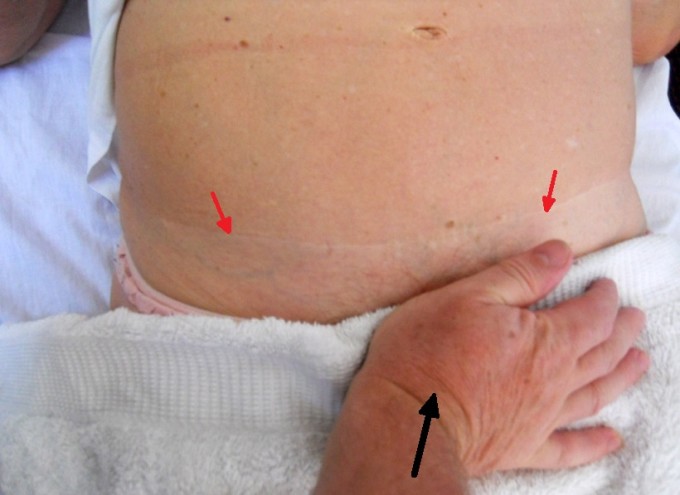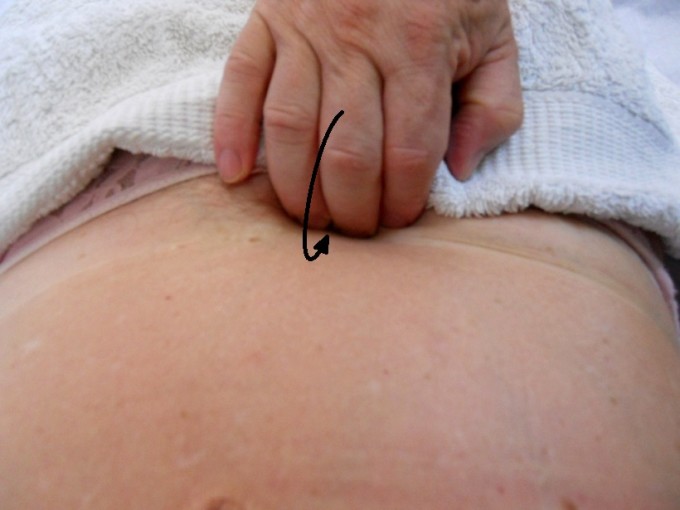By Dr. Ross Turchaninov
Two weeks ago a 62 year-old female patient was referred to our clinic by her new primary care physician. For the last 8 months she’s suffered from moderate intensity chronic lower abdominal pain which started one morning when she bent forward. Before coming to our clinic she went through all kinds of tests: gastroenterologist, gynecologist, abdominal and pelvic ultrasound, colonoscopy, pain clinics, etc. There weren’t any problems detected with her health. She was treated by three physical therapists, a chiropractor, an acupuncturist and at least two massage therapists with only temporary relief. She takes strong pain medications and is very depressed to the degree that she changed her primary care physician since she felt that no one cares or understands how difficult her life has become.
The pain is located on both sides of the middle line in the lower abdomen and it appears as soon as she starts to walk. The pain is local but persistent. Longer walks greatly increase the pain intensity. The only helpful information obtained during questioning was that she believed that her pain was somehow related to a personal training program in a local gym where she signed up two weeks prior to the onset of her pain.
She appeared to have full ROM in the lower back except tightness she felt in the lower abdomen at the end of rotations in the lower back. Visual evaluation confirmed the presence of a long scar in the lower abdomen which is the result of a tummy tack conducted more than 20 years ago. However, the patient said that she hasn’t had any lower abdominal pain for all these years. Palpatory examination of the lower back didn’t show any abnormalities. Examination of the abdominal muscles presented moderate tension in the rectus abdominis without any acute pain.
Considering the location of the pain, we first applied vertical pressure on the pubic symphysis (see Fig. 1) which triggered some poorly localized uncomfortable sensation in the lower abdomen.

Fig. 1. Test for Pubic Symphysis
Black arrow – the application of vertical pressure
Red arrows – postsurgical scar
The situation changed dramatically as soon as we applied even moderate pressure on and behind the upper edges of both pubic bones to both sides of the pubic symphysis (see Fig. 2). The patient almost jumped from the table and screamed that this is exactly the pain that bothered her for all these months but no one believed her. At this point it became obvious that the patient was suffering from periostal trigger points developed at the insertion of rectus abdominis into the pubic bones and pubic symphysis.

Fig. 2. Examination of periostal trigger points behind the upper edge of the right pubic bone
Black arrow – direction of the palpation applied behind the pubic bone
It took us ten days and three sessions of Medical Massage which included relaxation of the abdominal muscles using wave kneading, stretching of the abdominal muscles using forced abdominal breathing and Periostal Massage to eliminate periostal trigger points. For eight months while the patient was suffering from pain no one examined the place of insertion of the rectus abdominis into the pubic bones!
LESSONS:
1. Personal trainers are the biggest contributors to the somatic pathologies experienced by our patients, especially older ones.
2. Any scar, even an old one, forever changes the function of the soft tissues and this area is always prone to be more vulnerable compared to other parts of the body. In this particular case the presence of scarring after cosmetic surgery more likely contributed to the tension built up in the fascia. Intense exercise conducted by the patient under the guidance of a personal trainer triggered local tension in the rectus abdominis. Tension built up in the abdominal muscles which in turn put pressure at their insertion into the periosteum of pubic bones, triggering formation of the painful periostal trigger points there.
3. Relaxation of the involved muscles in combination with Periostal Massage are the best treatment tools to address periostal trigger points if they formed as a result of local trauma.
Category: Blog , News
